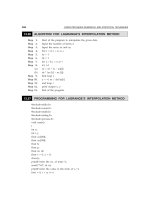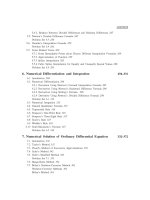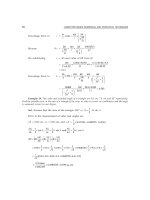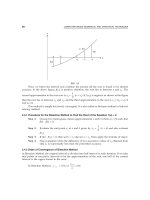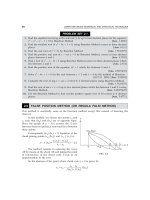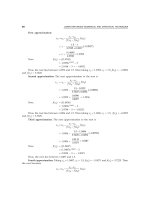A textbook of physical chemistry quantum chemistry and molecular spectroscopy (SI unit), 5e, volume 4
Bạn đang xem bản rút gọn của tài liệu. Xem và tải ngay bản đầy đủ của tài liệu tại đây (43.96 MB, 720 trang )
A Textbook of
Physical Chemistry
Volume IV
www.pdfgrip.com
A Textbook of Physical Chemistry
Volume
Volume
Volume
Volume
Volume
I
II
III
IV
V
:
:
:
:
:
States of Matter and Ions in Solution
Thermodynamics and Chemical Equilibrium
Applications of Thermodynamics
Quantum Chemistry and Molecular Spectroscopy
Dynamics of Chemical Reactions, Statistical Thermodynamics Macromolecules, and
Irreversible Processes
Volume VI : Computational Aspects in Physical Chemistry
www.pdfgrip.com
A Textbook of
Physical Chemistry
Volume IV
(SI Units)
Quantum Chemistry and Moucular Spectroscopy
Fifth Edition
k l kAPoor
Former Associate Professor
Hindu College
University of Delhi
New Delhi
McGraw Hill Education (India) Private Limited
New Delhi
McGraw Hill Education Offices
New Delhi New York St louis San Francisco Auckland Bogotá Caracas
Kuala lumpur lisbon london Madrid Mexico City Milan Montreal
San Juan Santiago Singapore Sydney Tokyo Toronto
www.pdfgrip.com
Published by McGraw Hill Education (India) Private Limited,
P-24, Green Park Extension, New Delhi 110 016.
A Textbook of Physical Chemistry, Vol IV
Copyright © 2015 by McGraw Hill Education (India) Private Limited.
No part of this publication may be reproduced or distributed in any form or by any means, electronic, mechanical, photocopying, recording, or otherwise or stored in a database or retrieval system without the prior written permission of the
publishers. The program listings (if any) may be entered, stored and executed in a computer system, but they may not be
reproduced for publication.
This edition can be exported from India only by the publishers,
McGraw Hill Education (India) Private Limited.
Print Edition
ISBN (13): 978-93-39204-29-7
ISBN (10): 93-39204-29-8
E-book Edition
ISBN (13): 978-93-392-0430-3
ISBN (10): 93-392-0430-1
Managing Director: Kaushik Bellani
Head—Higher Education (Publishing and Marketing): Vibha Mahajan
Senior Publishing Manager (SEM & Tech. Ed.): Shalini Jha
Associate Sponsoring Editor: Smruti Snigdha
Senior Editorial Researcher: Amiya Mahapatra
Senior Development Editor: Renu Upadhyay
Manager—Production Systems: Satinder S Baveja
Assistant Manager—Editorial Services : Sohini Mukherjee
Assistant General Manager (Marketing)—Higher Education: Vijay Sarathi
Senior Graphic Designer—Cover: Meenu Raghav
General Manager—Production: Rajender P Ghansela
Manager—Production: Reji Kumar
Information contained in this work has been obtained by McGraw Hill Education (India), from sources believed to
be reliable. However, neither McGraw Hill Education (India) nor its authors guarantee the accuracy or completeness
of any information published herein, and neither McGraw Hill Education (India) nor its authors shall be responsible
for any errors, omissions, or damages arising out of use of this information. This work is published with the
understanding that McGraw Hill Education (India) and its authors are supplying information but are not attempting
to render engineering or other professional services. If such services are required, the assistance of an appropriate
professional should be sought.
Typeset at Script Makers, 19, A1-B, DDA Market, Paschim Vihar, New Delhi 110 063, and text printed at
www.pdfgrip.com
To the Memory of My Parents
www.pdfgrip.com
www.pdfgrip.com
Preface
in recent years, the teaching curriculum of Physical Chemistry in many indian
universities has been restructured with a greater emphasis on a theoretical and
conceptual methodology and the applications of the underlying basic concepts and
principles. This shift in the emphasis, as i have observed, has unduly frightened
undergraduates whose performance in Physical Chemistry has been otherwise
generally far from satisfactory. This poor performance is partly because of the
non-availability of a comprehensive textbook which also lays adequate stress on
the logical deduction and solution of numericals and related problems. Naturally,
the students find themselves unduly constrained when they are forced to refer to
various books to collect the necessary reading material.
it is primarily to help these students that i have ventured to present a textbook
which provides a systematic and comprehensive coverage of the theory as well as
of the illustration of the applications thereof.
The present volumes grew out of more than a decade of classroom teaching
through lecture notes and assignments prepared for my students of BSc (General)
and BSc (honours). The schematic structure of the book is assigned to cover
the major topics of Physical Chemistry in six different volumes. Volume I
discusses the states of matter and ions in solutions. It comprises five chapters
on the gaseous state, physical properties of liquids, solid state, ionic equilibria
and conductance. Volume II describes the basic principles of thermodynamics
and chemical equilibrium in seven chapters, viz., introduction and mathematical
background, zeroth and first laws of thermodynamics, thermochemistry, second
law of thermodynamics, criteria for equilibrium and A and G functions, systems
of variable composition, and thermodynamics of chemical reactions. Volume III
seeks to present the applications of thermodynamics to the equilibria between
phases, colligative properties, phase rule, solutions, phase diagrams of one-,
two- and three-component systems, and electrochemical cells. Volume IV deals
with quantum chemistry, molecular spectroscopy and applications of molecular
symmetry. it focuses on atomic structure, chemical bonding, electrical and
magnetic properties, molecular spectroscopy and applications of molecular
symmetry. Volume V covers dynamics of chemical reactions, statistical and
irreversible thermodynamics, and macromolecules in six chapters, viz., adsorption,
chemical kinetics, photochemistry, statistical thermodynamics, macromolecules
and introduction to irreversible processes. Volume VI describes computational
aspects in physical chemistry in three chapters, viz., synopsis of commonly used
statements in BASiC language, list of programs, and projects.
The study of Physical Chemistry is incomplete if students confine themselves
to the ambit of theoretical discussions of the subject. They must grasp the practical
significance of the basic theory in all its ramifications and develop a clear
perspective to appreciate various problems and how they can be solved.
www.pdfgrip.com
viii
Preface
it is here that these volumes merit mention. Apart from having a lucid style
and simplicity of expression, each has a wealth of carefully selected examples and
solved illustrations. Further, three types of problems with different objectives in
view are listed at the end of each chapter: (1) Revisionary Problems, (2) Try Yourself
Problems, and (3) Numerical Problems. Under Revisionary Problems, only those
problems pertaining to the text are included which should afford an opportunity to
the students in self-evaluation. in Try Yourself Problems, the problems related to
the text but not highlighted therein are provided. Such problems will help students
extend their knowledge of the chapter to closely related problems. Finally, unsolved
Numerical Problems are pieced together for students to practice.
Though the volumes are written on the basis of the syllabi prescribed for
undergraduate courses of the University of Delhi, they will also prove useful to
students of other universities, since the content of physical chemistry remains the
same everywhere. in general, the Si units (Systeme International d’ unite’s), along
with some of the common non-Si units such as atm, mmhg, etc., have been used
in the books.
Salient Features
∑
Comprehensive coverage of wave mechanics, energy quantization and atomic
structure, theories of covalent bond, electrical and magnetic properties of
molecules, molecular spectroscopy, molecular symmetry and its applications
∑
emphasis given to applications and principles
∑
explanation of equations in the form of solved problems and numericals
∑
iUPAC recommendations and Si units have been adopted throughout
∑
Rich and illustrious pedagogy
Acknowledgements
i wish to acknowledge my greatest indebtedness to my teacher, late Prof. R P
Mitra, who instilled in me the spirit of scientific inquiry. I also record my sense
of appreciation to my students and colleagues at hindu College, University of
Delhi, for their comments, constructive criticism and valuable suggestions
towards improvement of the book. i am grateful to late Dr Mohan Katyal (St.
Stephen’s College), and late Prof. V R Shastri (Ujjain University) for the numerous
suggestions in improving the book. i would like to thank Sh. M M Jain, hans Raj
College, for his encouragement during the course of publication of the book.
i wish to extend my appreciation to the students and teachers of Delhi
University for the constructive suggestions in bringing out this edition of the book.
i also wish to thank my children, Saurabh-Urvashi and Surabhi-Jugnu, for many
useful suggestions in improving the presentation of the book.
Finally, my special thanks go to my wife, Pratima, for her encouragement,
patience and understanding.
www.pdfgrip.com
Feedback request
The author takes the entire responsibility for any error or ambiguity, in fact or
opinion, that may have found its way into this book. Comments and criticism
from readers will, therefore, be highly appreciated and incorporated in subsequent
editions.
K L Kapoor
Publisher’s Note
McGraw-hill education (india) invites suggestions and comments from you, all
of which can be sent to (kindly mention the title and
author name in the subject line).
Piracy-related issues may also be reported.
www.pdfgrip.com
www.pdfgrip.com
Contents
Preface
Acknowledgements
1.
WaVE MEcHaNIcs, ENErGy QuaNtIzatIoN aND atoMIc structurE
1.1
1.2
1.3
1.4
1.5
1.6
1.7
1.8
1.9
1.10
1.11
1.12
1.13
1.14
1.15
2.
1
Towards Quantum Theory 1
Towards the wave Nature of the electron 22
Schrödinger wave Theory 30
Quantization of Translational energy 37
Quantization of Vibrational energy 58
Quantization of Rotational energy of Diatomic Molecules 69
Quantization of electronic energy: The hydrogen Atom 80
Pictorial Representations of wave Functions and Probability Density
Distributions for hydrogen-like Species 99
Angular Momentum and the Magnetic Moment 112
Zeeman and Anomalous Zeeman effects 116
Many-electron atoms 123
The indistinguishability of electrons and the Pauli exclusion
Principle 129
Atomic Term Symbols 134
hund’s Rule 139
The Aufbau Principle and The Electronic Configurations of Atoms 140
Annexure i
Derivation of de Broglie Relation for a Photon 157
Annexure ii
Solutions of Schrödinger equation for a harmonic Oscillator 159
Annexure iii
Operators for the Components of Angular Momentum 170
Annexure iV
Commutators of Angular Momentum Operators 177
Annexure V
Transformation of laplacian Operator from Cartesian
Coordinates to Spherical Polar Coordinates 183
Annexure Vi
Splitting of Schrödinger equation of hydrogen Atom 185
Annexure Vii Atomic Units 188
Annexure Viii The ladder-Operator Method Applied to Angular
Momentum 190
Annexure iX
electronic Transitions in hydrogen Atom including
Spin-Orbit Coupling 202
Annexure X
First-Order Perturbation Theory 204
Annexure Xi
Proof of Variational Theorem 212
Annexure Xii The Variational Method 213
tHEorIEs of coVaLENt BoND
2.1
2.2
vii
viii
introduction 220
expression of Schrödinger equation 220
220
www.pdfgrip.com
xii
Contents
2.3
2.4
2.5
2.6
2.7
2.8
2.9
2.10
2.11
2.12
2.13
2.14
2.15
2.16
3.
ELEctrIcaL aND MaGNEtIc ProPErtIEs of MoLEcuLEs 341
3.1
3.2
3.3
3.4
3.5
3.6
3.7
3.8
3.9
3.10
3.11
3.12
3.13
3.14
3.15
3.16
3.17
3.18
4.
Born-Oppenheimer Approximation 221
Two Approaches For Approximate Solution of Schrödinger equation 222
lCAO-MO Treatment of h+2 228
lCAO-MO Treatment of a hydrogen Molecule 240
Valence-Bond Treatment of a hydrogen Molecule 242
Comparison Between MO and VB Treatments of a hydrogen Molecule 249
Mo Treatment of homonuclear Diatomic Molecules 252
Molecular Term Symbols 261
h eteronuclear Diatomic Molecules 263
United-Atom Concept and the Correlation Diagrams 268
hybrid Orbitals 272
Triatomic Molecules 282
Correlation of the Orbitals for Bent and linear Ah2 Molecules 306
Conjugated Organic Molecules 309
Annexure i localized Molecular Orbitals of CO and N2 Molecules 329
Annexure ii evaluation of integrals J, K and S in the lCAO-MO
Treatment of h+2 335
Annexure iii Conventional Representation of Sp3 hybrid Orbitals 338
introduction 341
e lectric Dipole Moment 341
effect of A Dielectric on the electrostatic Field of a Parallel Plate Capacitor 345
Clausius-Mosottii equation 346
Debye equation 348
e xperimental Method to Determine a and P 351
Variation of Molar Polarization with the Frequency of electric Field 353
lorentz-lorenz equation 354
Union of the Debye and the lorentz-lorenz equations 357
ionic Character of Diatomic Molecules 360
Bond Moments 360
Group Moments 367
Applications of Dipole Moments 370
Magnetic Field in a Substance 371
Molecular interpretation of Diamagnetism and Paramagnetism 371
Total Molar Magnetic Susceptibility 374
Calculation of the Number of Unpaired electrons 374
Gouy Balance Method to Measure Magnetic Susceptibility 375
Annexure i e lectrostatic and Magnetic Fields 383
Annexure ii expression of Orientation Polarizability 391
MoLEcuLar sPEctroscoPy 393
4.1
4.2
4.3
introduction 393
Nuclear Magnetic Resonance Spectroscopy 401
electron Spin Resonance Spectroscopy 430
www.pdfgrip.com
Contents xiii
4.4
4.5
4.6
4.7
4.8
4.9
5.
Rotational Spectra of Diatomic Molecules 443
Vibrational Spectra of Diatomic Molecules 460
Vibration-Rotation Spectra of Diatomic Molecules 480
Vibration Spectra of Polyatomic Molecules 485
Raman Spectra 488
electronic Spectra of Diatomic Molecules 500
Annexure A Qualitative Study of Quantum Mechanical Treatment of
Spin Transitions in AX, A2 and AX2 Systems 527
MoLEcuLar syMMEtry aND Its aPLIcatIoNs 536
5.1
5.2
5.3
5.4
5.5
5.6
5.7
5.8
5.9
5.10
5.11
5.12
5.13
5.14
5.15
5.16
5.17
5.18
5.19
5.20
5.21
5.22
5.23
5.24
Symmetry elements and Associated Symmetry Operations 536
Classification of Molecules Based on Symmetry Elements 542
Matrix Representations of Geometrical Operations 548
Definition of a Group 551
Group consisting of Symmetry Operations on a Molecule 552
Classes of Symmetry Operations 559
A Few Representations of Symmetry Operations of a Point Group 560
Reducible and irreducible Representations 581
Characters of Matrices 583
The Great Orthogonality Theorem 584
Characteristics of irreducible Representations 586
worked out examples of irreducible Representations of a Group 588
Resolution of a Reducible Representation in Terms of irreducible
Representations 590
Description of a Character Table 592
Description of Mulliken Symbols 592
Reducible Representation Based on Translational Vectors and its Resolution
into irreducible Representations–Revisited 593
The Projection Operator 597
worked out examples of Salc’s and Mo’s 602
P-Molecular Orbitals of A Carbocyclic System 621
Formation of hybrid Orbitals 628
Predicting Zero Value of an integral 639
irreducible Representations of Vibrational Motions 656
Predicting Probability of a Spectral Transition 661
Correlation Diagrams For a D2 ion in an Octahedral and
Tetrahedral environments 670
Annexure Some Commonly Used Character Tables 689
Appendix I Units and Conversion Factors
Appendix II Some Mathematical expressions and Greek Alphabets
697
701
Index
703
www.pdfgrip.com
1
1.1
Wave Mechanics, Energy Quantization
and Atomic Structure
TOWARDS QUANTUM THEORY
Introduction
During the latter of the nineteenth century, a number of experimental observations
were reported which could not be explained on the basis of the classical theory.
Among these were the spectral distribution of energy in black-body radiation,
photoelectric effect, variation of heat capacity of monatomic solids with temperature,
and the discrete spectra emitted by excited atoms. These observations established
that the classical theory was unable to account for the behaviour of small objects.
a new theory based on the quantum behaviour of energy. When applied to various
problems, it was able to account for the experimental observations and hence led
to the new theory, named, the quantum theory. In this section, we shall describe
how the quantum theory postulated by Planck could explain the experimental
observations listed above.
BLACK–BODY RADIATION
Classical Theory
of Radiation
Prior to Max Planck (1901), light was considered to be electromagnetic wave
whose energy was proportional to the square of the amplitude of the wave, and
was considered to be independent of the frequency of the radiation. This classical
theory of radiation was able to explain optical phenomena such as diffraction and
scattering. However, when applied to the black-body radiation, this theory could
not explain the relative intensities of radiations emitted from a black-body when
heated to a higher temperature.
Radiations
Emitted by a
Black-Body
A black-body is one which can absorb all types of radiation that falls upon it.
Experimentally, such a body is best represented by a hollow container with a
very small hole in the wall. When such a body is heated, it emits radiations of
all types of wavelengths. The origin of radiations from a heated body is the rapid
vibrating particles (known as oscillators) composing the body. According to
Maxwell’s electromagnetic theory, these oscillators emit radiant energy in the form
of electromagnetic waves. The frequency of the wave emitted from an oscillator is
equal to the frequency of the latter. At low temperatures, the emission is mainly in
the infrared region, but as the temperature is raised, the wavelength at which most
of the light is emitted shifts towards the blue region of the spectrum. The intensity
of the emitted radiation depends on the temperature of the container as well as on
the wavelength of the radiation. Figure 1.1.1 shows the variation of the intensity
of radiation with the wavelength at three different temperatures.
www.pdfgrip.com
2
A Textbook of Physical Chemistry
T1
Fig. 1.1.1 Variation
of intensity of
radiation with the
wavelength of emitted
radiations at three
different temperatures
Two Fundamental
Laws of BlackBody Radiations
Intensity of radiation
T1 > T2 > T3
T2
T3
0
1
2
3
l / 10–6 m
4
5
6
Based on the classical theory, attempts were made to explain qualitatively and
quantitatively the nature of the curves depicted in Fig. 1.1.1. Two fundamental
laws regarding the nature of the curves were established. These are described below.
Stefan-Boltzman law This law was established experimentally by Stefan,
according to which, the intensity E of total radiation (the area under the curve) is
proportional to the fourth power of the kelvin temperature T, i.e.
4
E = s ¢T 4 = ÊÁ s ˆ˜ T 4
¯
Ë
c
(1.1.1)
where s is a constant, known as the Stefan’s constant. Its value is found to be
5.672 ¥ 10-8 J m-2 s-1 K-4. Subsequently, this law was derived by Boltzmann using
thermodynamic principles.
Wien's displacement law According to this law, the wavelength l at the
maximum of the spectral distribution is inversely proportional to the temperature
T. Thus
l max T = constant
(1.1.2)
Various Attempts to
Construct the
Spectra
Theoretical attempts were also made to construct the shape of the energy spectra
as a function of wavelength. We describe below the three important attempts in
this direction.
Wien's contribution Based on the classical electromagnetic theory and
assuming that the oscillators from which the radiations are emitted are of molecular
size, Wien was able to obtain the expression
a
(1.1.3)
E = 5 exp(– b/lT )
l
where E is the energy emitted between wavelengths l and l + dl and a and b are
constants.
curves in the low wavelength region, but fails to reproduce the results at the high
wavelength region (Fig. 1.1.2).
www.pdfgrip.com
Wave Mechanics, Energy Quantization and Atomic Structure
Fig. 1.1.2
3
Graph
of the experimental
curve by Wien’s law,
Rayleigh–Jeans’ law
and Planck’s law
Rayleigh–Jeans contribution Applying the classical law of equipartition of
energy (that each vibration mode possesses on an average energy E equal to kT )
to the oscillators of black-body, Rayleigh and Jeans derived Eq. (1.1.6) as follows.
It can be shown that the number dn of modes of oscillation in the wavelength
range l and l + dl per unit volume of the cavity is given by
8p
dl
(1.1.4)
l4
The energy density in this wavelength region is equal to (dn)( E ) and is also
equal to El dl, where El is the corresponding energy emitted. Thus, we have
dn =
El dl = (dn) E
(1.1.5)
Substituting the expressions of dn and E , we get
8p ˆ
El dl = Ê
dl (kT )
Ë l4 ¯
8pkT
(1.1.6)
l4
According to Eq. (1.1.6), El is inversely proportional to the fourth power of the
wavelength. Hence, El continues to increase with decreasing l.
Hence
El =
Equation (1.1.
region but fails completely at the low wavelength region and thus leads to what
is known as the ultraviolet catastrophe (Fig. 1.1.2).
Planck's contribution Keeping in view that the Wien’s relation was applicable
in the low wavelength region and that of Rayleigh-Jeans in the high wavelength
region, Planck sought an intermediate expression which could be reduced to the
above two laws in the proper range of values of l. He derived the expression:
El =
a
l {exp(b/lT ) - 1}
5
(1.1.7)
Behaviour of Eq. (1.1.7) at low values of l The factor exp(b/lT) is very much
greater than one, and thus we may write
www.pdfgrip.com
4
A Textbook of Physical Chemistry
exp(b/lT ) - 1 exp(b/lT )
With the above relation, Eq. (1.1.7) reduces to
a
El = 5 exp(-b/lT )
l
an expression identical to the Wien’s relation (Eq. 1.1.3).
Behaviour of Eq. (1.1.7) at high values of l If l is high, the term b/lT will
have a small value and thus the term exp(b/lT ) can be written as
b
exp(b/lT ) 1 +
lT
Substituting the above relation in Eq. (1.1.7), we get
El =
or
El =
a
l
5
1
a
1
a lT
= 5
= 5
exp(b / lT ) - 1
l 1 + (b / lT ) - 1
l b
aT
l 4b
which is identical to the Rayleigh-Jeans’ relation (Eq. 1.1.6) provided (a/b) = 8pk.
Theoretical Model
of Planck
After obtaining the expression for the energy distribution in black-body radiation,
Planck put forward a theoretical model in order to explain the results. He
completely rejected the classical principle of equipartition of energy since this
assumption led to the Rayleigh-Jeans expression. Instead, he used the bold
assumption that the oscillator of the black-body cannot have any amount of energy
but has a discrete energy equal to the integral multiple of some minimum energy
e , i.e.
e i = ne
(1.1.8)
where ei is the energy of the ith oscillator and n is an integer.
Average Energy
of the Oscillator
After this, he employed the Boltzmann expression to compute the average energy
of the oscillator. According to the Boltzmann law, the number of oscillators having
energy ei at temperature T is given by
Ni = n0 exp(- ei /kT)
(1.1.9)
where n0 is a constant. With this expression, the average energy of the oscillator
can be computed as follows.
Total number of oscillators, N = Â i Ni
Substituting Ni from Eq. (1.1.9), and by using Eq. (1.1.8), we get
N = n0 + n0 exp(- e /kT) + n0 exp(- 2e/kT ) +
= n0 (1 + x + x 2 + )
where x = exp(- e /kT)
Equation (1.1.10) can be written as
n0
1- x
since the expansion of (1 - x)-1 gives (1 + x + x 2 +
(1.1.10)
(1.1.11)
N=
(1.1.12)
).
www.pdfgrip.com
Wave Mechanics, Energy Quantization and Atomic Structure
5
Now, the average energy E is given by
E =
 i ( Ni e i )
N
Employing Eqs (1.1.8), (1.1.9) and (1.1.11), we get
1
1
2
E =
[ N 0 (0) + N1 (e ) + N 2 (2e ) + ] = ÈỴn0e( x + 2 x + )˘˚
N
N
1 Èn e x(1 + 2 x + 3 x 2 + ) ˘
(1.1.13)
=
Ỵ 0
˚
N
The expression within the bracket is equal to 1/(1 - x) 2. It can be proved as follows.
1
d Ê 1 ˆ
d
(1 + 2x + 3x2 + ) =
(1 + x + x2 + x3 + ) =
˜ =
Á
dx Ë 1- x ¯
(1 - x) 2
dx
With the above equality, Eq. (1.1.13) becomes
n0 e x / (1 - x )2
N
which on using Eq. (1.1.12) becomes
E =
n0 e x / (1 - x )2
ex
=
E =
n0 / (1 - x )
1- x
i.e.
Energy Emitted
at Wavelength l
E =
e exp(-e/kT )
1 - exp(-e/kT )
=
e
exp(e/kT ) -1
(1.1.14)
Substituting Eq. (1.1.14) and the expression of dn in Eq. (1.1.5), we get
e
ˆ
8p dl ˆ Ê
El dl = ÊÁ
Ë l 4 ˜¯ ÁË exp(e / kT ) - 1˜¯
e
ˆ
8p Ê
˜
Á
l 4 Ë exp(e / kT ) - 1¯
Comparing Eqs (1.1.7) and (1.1.15), we have
a = 8pel
bk
e
b
or l =
=
and
e
k
l
Eliminating l in the above two expressions, we have
Hence
El =
(1.1.15)
bk
a = (8pe) ÊÁ ˆ˜
Ë e ¯
or
Reduction to
Rayleigh–Jeans’
Relation
a = 8pbk
In Eq. (1.1.15), e represents some minimum energy. If it be assumed that e is
e Ỉ 0), it can be shown that the present
approximation would lead to the classical expression of Rayleigh and Jeans. This
is to be expected since the actual energy of an oscillator which is an integral
www.pdfgrip.com
6
A Textbook of Physical Chemistry
continuously—an assumption of the classical theory. In the above approximation,
we will have
exp(e /kT)
and thus El =
Reduction to
Wien’s Relation
8p
l4
1+
e
kT
e
¸
Ï
8pkT
˝ =
Ì
(
kT
)
1
+
e
1
l4
˛
Ĩ
(Eq. 1.1.6)
In order that Eq. (1.1.15) could be reduced to the Wien’s relation in the low
wavelength region, Planck also took the bold step to state that the energy e is
directly proportional to the frequency of the radiation, i.e.
e μn
or
e = hn
(1.1.16)
where h is the Planck’s constant and has a value of 6.6252 ¥ 10-34 J s.
Since n = c/l, we have
hc
(1.1.17)
e =
l
Substituting Eq. (1.1.17) in Eq. (1.1.15), we have
8p(hc / l )
l {exp(hc / l kT ) - 1}
Now for low values of l , we will have
exp(hc/lkT )
1
El =
4
(1.1.18)
With the above relation, the expression of El is reduced to
8phc
exp(- hc/lkT )
(1.1.19)
l5
Comparing the above expression with the Wien’s relation (Eq. 1.1.3), we have
a = 8phc
hc
b =
k
With Eq. (1.1.18), it is possible to reproduce the relative intensities of radiations
from a black-body as a function of wavelength, both in the low and high
wavelength regions of the spectrum (Fig. 1.1.2). The wavelength at which the
maximum in the spectral distribution of energy of Fig. 1.1.1 is observed can be
computed by differentiating Eq. (1.1.18) with respect to l and then setting the
resultant expression to zero. Starting with the simpler relation given by Eq. (1.1.19),
we have
El =
Wavelength of
Radiation having
Maximum Spectral
Energy
dEl
d
[l-5 exp(-hc/lkT )] = 0
= 8phc
dl
dl
or
È(-5)(l -6 ) + l -5 Ê hc ˆ ˘ exp(-hc/lkT ) = 0
ÁË 2 ˜¯ ˙
ÍỴ
l kT ˚
www.pdfgrip.com
Wave Mechanics, Energy Quantization and Atomic Structure
Thus
(- 5)(l-6) +
hc
7
=0
l 7 kT
hc
= constant
5k
This expression is, in fact, Wien’s displacement law (Eq. 1.1.2).
or
lT =
Summary of
Planck’s
Contribution
Planck’s contribution may be summarized as follows:
Problem 1.1.1
Starting from Planck’s radiation law, obtain the Stefan–Boltzmann law E = s ¢T 4 where
E is the total radiation energy from l = 0 to l = •, i.e.
∑ In order that the Planck’s equation (1.1.7) may be reduced to Rayleigh and
Jeans’equation (1.1.6) only in the longer wavelength region, Planck assumed
that the oscillator in a black-body can exchange energy only by discrete amounts,
i.e. the oscillator cannot radiate or absorb any amount of energy but can do so
only in small lumps or bundles called quanta.
∑ In order that the Planck’s equation may be reduced to the Wien’s equation
(1.1.3) only in the low wavelength region, Planck assumed that the energy of
the oscillator is directly proportional to its frequency with h as the constant of
proportionality. This constant is called Planck’s constant and it has to have a
h cannot be zero since this would lead to the classical
theory of continuous energy distribution.
•
E=
Ú El dl = s ÂT
ã
4
Given:
0
Solution
x 3 dx
(e x - 1)
0
The Plancks equation is
El =
Let
8phc
l {exp(hc l kT ) - 1}
5
x = hc/lk T. Therefore
l = hc/xkT and dl = - hc dx/x 2kT
Substituting the above relations in the Planck’s equation, we get
El =
Thus
8phc
(hc / xkT )5 (e x - 1)
El dl =
8phc
Ê - hc dx ˆ = E dx
x
(hc / xkT )5 (e x - 1) ÁË x 2 kT ˜¯
Integrating the above expression from 0 to •, we have
•
E =
Ú El dl =
0
0
0
Ú Ex dx =
Ú (hc / xkT )5 (e x - 1) ÁË - x 2 kT ˜¯
•
•
8phc
Ê
hc ˆ
dx
=
p4
15
www.pdfgrip.com
8
A Textbook of Physical Chemistry
0
8p x3k 4T 4
8pk 4T 4
dx
=
–
(hc)3 (e x - 1)
(hc)3
•
= –Ú
=–
0
x3
Ú e x - 1 dx
•
8pk 4T 4 Ê p 4 ˆ
8p 5 k 4 4
=
T
(hc)3 ÁË 15 ˜¯
15(hc)3
= s ¢T 4
where
s ¢ = 8p 5k4/15(hc)3.
THE PHOTOELECTRIC EFFECT
The Planck’s statement that the oscillators in a black-body radiate energy in
elementary discrete units was extended by Einstein to the extent that the radiation
photons. Thus, Einstein
considered the light wave to be corpuscular in nature with each photon carrying
an energy equal to hn. With the corpuscular nature of light, he was successful in
interpreting the photoelectric effect.
Characteristics
of Photoelectric
Effect
In the photoelectric effect, the electrons are emitted instantaneously from a clean
metal plate in vacuum when a beam of light falls on it. The following characteristics
are observed:
∑ The electrons are emitted instantaneously from a given metal plate when it is
irradiated with radiation of frequency equal to or greater than some minimum
frequency, called the threshold frequency.
∑ The kinetic energy of the emitted electrons depends on the frequency of the
incident radiation and not on its intensity. The kinetic energy of electrons
increases linearly with increase in the frequency of the incident radiation.
∑ The number of electrons emitted is proportional to the intensity of the incident
radiation.
Energy
Requirement for
the Emission of
Electrons
The electron in a metal possesses potential energy (PE) which must be supplied
before an electron can be removed from the metal. This energy, known as the work
function, is the ionization energy (IE) of the metal. If the emitted electron carries
some kinetic energy (KE), the total energy supplied to the electron is equal to the
sum of its potential energy and kinetic energy.
Failure of Classical
Theory to Explain
Photoelectric Effect
In the classical theory, the energy of the light beam depends on its intensity. Thus,
a continuous exposure of the metal with light causes the electron to gain more
and more energy from the light and ultimately a stage would be reached when it
there might exist a time interval between the exposure of the metal and the
emission of electron. This time interval may be decreased by increasing the
intensity of the light. Thus, the classical theory of light cannot explain the
characteristics of photoelectric effect listed above, viz., the instantaneous emission
www.pdfgrip.com
Wave Mechanics, Energy Quantization and Atomic Structure
9
of electrons, existence of threshold frequency and the dependence of kinetic energy
of the emitted electron on the frequency of the light.
Einstein
Explanation of
Photoelectric Effect
According to Einstein, the above characteristics can be explained by employing
Planck’s idea of quantization of energy. Thus, light may be considered to be made
up of discrete particles called photons. Each photon carries an energy equal to
hn. When this photon collides with the electron of the metal, the electron acquires
energy equal to the energy of the photon. Thus, the energy of the emitted electron
is given by
1
mu 2 + IE
hn = KE + PE =
(1.1.20)
2
If the incident radiation is of threshold frequency, the electron will be emitted
without any kinetic energy. In this case, we have
hn0 = IE
(1.1.21)
It is obvious that if the frequency of the light is smaller than n0, the electron will
From Eq. (1.1.20), it follows that the kinetic energy of electrons depends on
the frequency of incident radiation and not on the intensity of light. By the term
intensity of light, we mean the number of quanta striking the metal per unit time.
This will have an effect only on the number of electrons emitted and not on their
kinetic energy. Thus, the number of electrons emitted increases with increase in
the intensity of light.
Kinetic Energy of
Emitted Electrons
Combining Eqs (1.1.20) and (1.1.21), we have
hn = KE + hn0 or KE = hn - hn 0
(1.1.22)
From Eq. (1.1.22), it may be concluded that the kinetic energy of the emitted
electrons varies linearly with the frequency of the incident radiation. A plot of
kinetic energy of the emitted electrons versus frequency of the incident radiation
yields a straight line with slope equal to the Planck’s constant h (Fig. 1.1.3). This
provides one of the methods to determine the value of Planck’s constant.
Fig. 1.1.3 Variation
of kinetic energy of the
emitted electrons with
the frequency of the
incident radiation
www.pdfgrip.com
10
A Textbook of Physical Chemistry
Experimental
Determination of
Kinetic Energy of
Emitted Electrons
The kinetic energy of emitted electrons can be determined with a device shown in
Fig. 1.1.4. In this method, a retarding voltage is applied and its value is steadily
increased till no electrons from the metal plate reach the collector plate (Fig. 1.1.5).
Light beam
+
e–
Metal
plate
–
Collector
G
Photoelectric
current
Fig. 1.1.4 Experimental
device to determine the
kinetic energy of the
emitted electrons
Fig. 1.1.5 Decrease of
photoelectric current
with the retarding
potential
Vr
0
Anode voltage
+V
The electrical work done in the above process is Vr e, where Vr is the retarding
voltage and e is the electronic charge. The electrical work will be equal to the
kinetic energy of the electrons. Thus, we have
1
mu2 = hn - hn0
(1.1.23)
|Vr e| =
2
Example 1.1.1
Solution
(a) Calculate the kinetic energy of a photoelectron emitted by a sodium surface when
light of wavelength 400 nm is incident on it. The work function of sodium is 2.28 eV.
(b) Calculate the value of the longest wavelength which can result in the emission of a
photoelectron from a sodium surface.
(a) Energy of the incident photon is
E1 =
(6.626 ¥ 10-34 J s)(3 ¥ 108 m s -1 )
hc
=
= 4.969 ¥ 10-19 J
l
(400 ¥ 10-9 m)
www.pdfgrip.com
Wave Mechanics, Energy Quantization and Atomic Structure
11
The work function of sodium is
E2 = 2.28 eV ∫ (2.28 eV) (1.602 ¥ 10-19 J/1 eV)
= 3.653 ¥ 10-19 J
Energy carried by the electron is
E3 = E1 – E2 = 4.966 ¥ 10-19 J - 3.653 ¥ 10-19 J = 1.316 ¥ 10-19 J
(b)
l=
hc
(6.626 ¥ 10-34 J s)(3 ¥ 108 m s -1 )
=
work function
(3.653 ¥ 10-19 J )
= 5.441 ¥ 10-7m = 544.1 nm
HEAT CAPACITY
Heat Capacity
Based on the Law
of Equipartition of
Energy
Einstein also showed that the problem of variation of heat capacity of monatomic
solids with temperature can be resolved by employing Planck’s idea of quantization.
The monatomic solid may be considered a collection of oscillators with three
vibrational degrees of freedom. On the basis of the classical law of equipartition
of energy, each oscillator of such a solid possesses an average energy equal to 3kT.
Thus, for one mole of oscillators, the molar energy is
E = NA (3kT ) = 3RT
(1.1.24)
Since CV = (∂ E/∂T )V, we have
CV = 3R
(1.1.25)
According to Eq. (1.1.25), monatomic solids have a constant heat capacity equal
to 3R (a value which was obtained empirically by Dulong and Petit). Experimentally,
it is found that this value of heat capacity is observed only at high temperatures.
Disagreement with
Experimental Fact
According to the classical theory, the heat capacity of a monatomic solid should
be independent of temperature. This conclusion, however, does not agree with
the decrease in temperature. Figure 1.1.6 depicts such variations for Pb, Cu,
Si and C.
Einstein
Explanation of
Variation of Heat
Capacity
By employing Planck’s idea of quantization, Einstein was able to explain the
variation of heat capacity with temperature. He assumed that the oscillator can
have vibrational energy which is an integral multiple of some minimum value, i.e.
E = ne
or
n = nn0
(1.1.26)
where n is the frequency of the oscillator and n0 is the smallest allowed frequency.
Thus, all oscillators are not vibrating with the same frequency but have values
which are simply an integral multiple of the smallest frequency n 0. The number
of oscillators possessing the frequency n can be determined from Boltzmann
law (Eq. 1.1.9).
www.pdfgrip.com
12
A Textbook of Physical Chemistry
Fig. 1.1.6 The
variation of molar
heat capacity with
temperature for Pb,
Cu, Si and C
The average energy of the oscillators as given by Eq. (1.1.14) is
E =
e
exp(e / kT ) -1
Substituting e = hn0 , we get
E =
hn 0
exp(hn 0 / kT ) - 1
(1.1.27)
The molar energy of a solid is
hn 0
Ï
¸
E = NA (3 E ) = NA Ì3
˝
Ó exp(hn 0 / kT ) - 1 ˛
(1.1.28)
and the corresponding value of molar heat capacity is
2
exp(hn 0 / kT )
Ê hn 0 ˆ
Ê ∂E ˆ
CV = ÁË ˜¯ = 3 NAk Á
˜
Ë kT ¯ {exp(hn / kT ) - 1}2
∂T V
0
(1.1.29)
Equation (1.1.29) is known as Einstein equation.
Limiting Value of
CV at Lower
Temperatures
At low temperatures, we have
hn0
kT
and thus exp(hn0/kT)
1. Under these conditions, Eq. (1.1.29) will reduce to
Ê hn 0 ˆ
CV = 3NAk Á
Ë kT ˜¯
2
exp(- hn0 /kT )
(1.1.30)
On decreasing the temperature, the exponential factor decreases much faster than
the corresponding increase in the factor (hn0 /kT)2. Consequently, CV decreases
with decrease in temperature. Einstein suggested that the above decrease is
basically due to the lesser absorption of energy by the oscillators at low
temperatures. This is so because the oscillators can absorb energy in units of hn 0
and the value of kT is much smaller as compared to hn 0.



